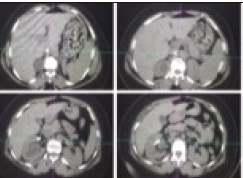Complications of endourological procedures and their treatment

Accepted: October 21, 2020
Supplementary Files: 113
All claims expressed in this article are solely those of the authors and do not necessarily represent those of their affiliated organizations, or those of the publisher, the editors and the reviewers. Any product that may be evaluated in this article or claim that may be made by its manufacturer is not guaranteed or endorsed by the publisher.
Endourological treatment for urinary stones and other obstructive urinary tract diseases is minimally invasive but in some cases it involves serious complications. This collection of cases describes some complications of endourological procedures and how they were treated.
Case 1: A case of right ultrasound-guided percutaneous nephrostomy found to be misplaced in the inferior vena cava. The case was safely managed, but it showed that ultrasound guidance alone may be insufficient so it is recommended that percutaneous nephrostomy should be always placed under fluoroscopic control, either alone or in combination with ultrasound guidance.
Case 2: A case of renal subcapsular hematoma occurring on retrograde intrarenal surgery at high perfusion pressure. The hematoma was drained under combined ultrasonic and radiological guidance. Post treatment recovery was uneventful. Large stone size, severe ipsilateral hydronephrosis, long operation time, higher hydrostatic pressure of the irrigating solution and low ureteral wall compliance are supposed to be risks factors associated with renal subcapsular formation. Management strategy should be tailored to patient’s clinical conditions. In hemodynamically stable patients, large hematoma drainage is recommended to prevent further complications and favours early recovery.
Case 3: A case of double J stent fracture discovered one month after the insertion to relieve obstruction from a 1 cm stone in the right proximal ureter. The distal fragment of the stent was removed by cystoscopy while the proximal fragment was removed by semirigid ureteroscopy in two sessions due to fever and extensive calcification. Case 4: A mini-invasive technique for transurethral replacement of completely encrusted urinary stents in female patients. This technique allows the interventional radiologist to replace obstructed urinary stents by avoiding more invasive and traumatic urological procedures with sedation.
- Chua ME, Morales ML Jr. Spontaneous fracture of indwelling polyurethane ureteral stents: A case series and review of literature. Can Urol Assoc J. 2012;6(5):386-392. DOI: https://doi.org/10.5489/cuaj.12013
- Ray RP, Mahapatra RS, Mondal PP, Pal DK. Long-term complications of JJ stent and its management: A 5 years review. Urol Ann 2015;7:41–45 DOI: https://doi.org/10.4103/0974-7796.148599
- El-Faqih SR, Shamsuddin AB, Chakrabarti A et al (1991) Polyurethane internal ureteral stents in treatment of stone patients: morbidity related to indwelling times. J Urol 146:1487–1491 DOI: https://doi.org/10.1016/S0022-5347(17)38146-6
- Zisman A, Siegel YI, Siegmann A, Lindner A. Spontaneous ureteral stent fragmentation. J Urol. 1995;153(3 Pt 1):718–721. DOI: https://doi.org/10.1016/S0022-5347(01)67697-3
- Beiko DT, Knudsen BE, Watterson JD, Cadieux PA, Reid G, Denstedt JD. Urinary tract biomaterials. J Urol. 2004;171(6 Pt 1):2438–2444. DOI: https://doi.org/10.1097/01.ju.0000125001.56045.6c
- Mardis HK, Kroeger RM, Hepperlen TW, Mazer MJ, Kammandel H. Polyethylene double-pigtail ureteral stents. Urol Clin North Am. 1982;9:95–101.
- Bostanci Y, Ozden E, Atac F, Yakupoglu YK, Yilmaz AF, Sarikaya S. Single session removal of forgotten encrusted ureteral stents: Combined endourological approach. Urol Res 2012;40:523–529. DOI: https://doi.org/10.1007/s00240-011-0442-2
- Lam JS, Gupta M (2002) Tips and tricks for the management of retained ureteral stents. J Endourol 16:733–741 DOI: https://doi.org/10.1089/08927790260472881
PAGEPress has chosen to apply the Creative Commons Attribution NonCommercial 4.0 International License (CC BY-NC 4.0) to all manuscripts to be published.


 https://doi.org/10.4081/aiua.2020.4.321
https://doi.org/10.4081/aiua.2020.4.321



